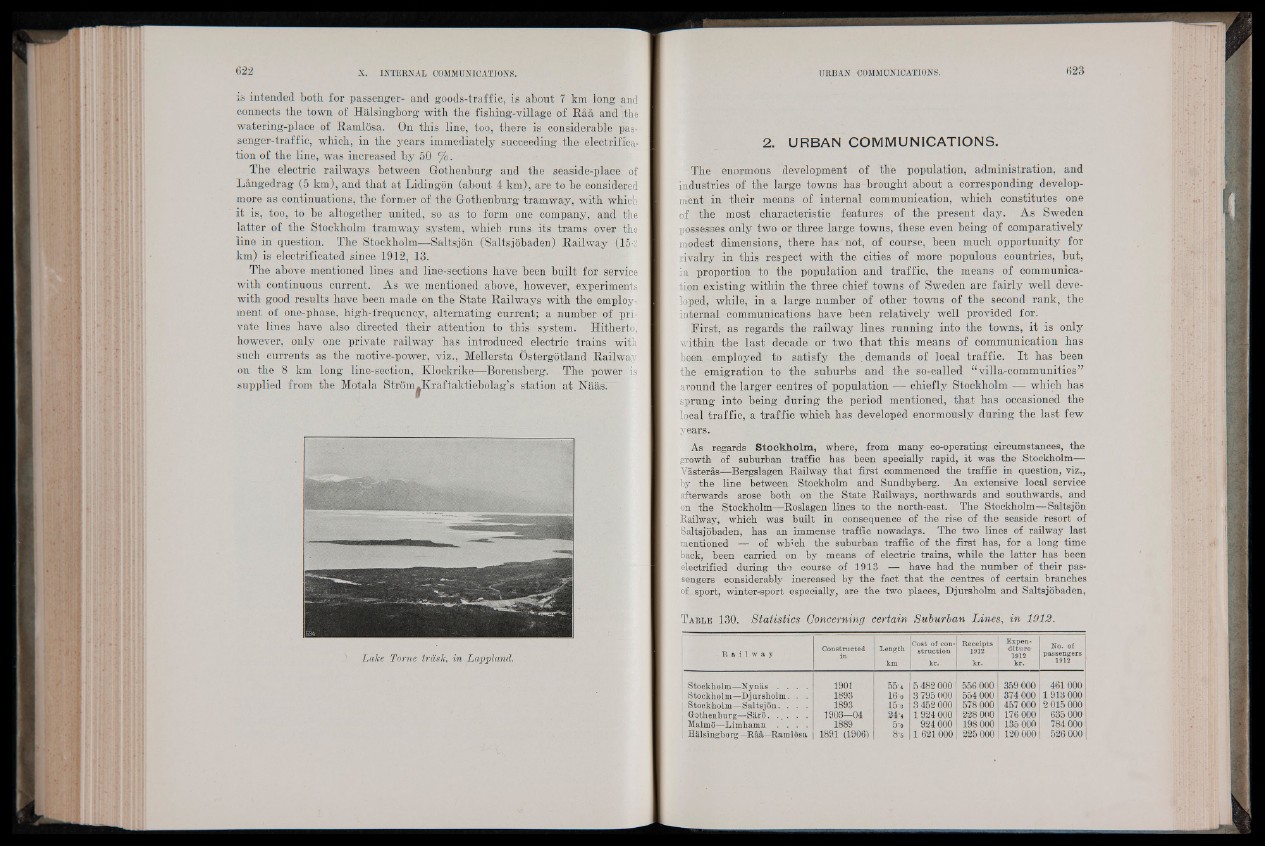
is intended both, for passenger- and goods-traffic, is about 7 km long and
connects the town of Halsingborg with the fishing-village of Ráá and the
watering-place of Ramlosa. On this line, too, there is considerable passenger
traffic, which, in the years immediately succeeding the electrification
of the line, was increased by 50 %.
The electric railways between Gothenburg and the seaside-place of
Lángedrag (5 km), and that at Lidingon (about 4 km), are to be considered
more as continuations, the former of the Gothenburg tramway, with which
it is, too, to be altogether united, so as to form one company, and the
latter of the Stockholm tramway system, which runs its trams over the
line in question. The Stockholm—-Saltsjon (Saltsjobaden) Railway'^lfi-
km) is electrificated since 1912, 13.
The above mentioned lines and line-sections have been built for service
with continuous current. As we mentioned above, however, experiments
with good results have been made on the State Railways with the employment
of one-phase, high-frequency, alternating current; a number of private
lines have also directed their attention to this system. Hitherto,
however, only one private railway has introduced electric trains with
such currents as the motive-power, viz., Mellersta Ostergotland Railway
on the 8 km long line-section, Klockrike—Boremsberg. The power is
supplied from the Mótala Strom.Kraftaktiebolag’s station ^at Naas. ""
Lake Tome träsk, in. Lappland.
2. URBAN COMMUNICATIONS.
The enormous development of the population, administration, and
industries of the large towns has brought about a corresponding development
in their means of internal communication, which constitutes one
of the most characteristic features of the present day. As Sweden
possesses only two or three large towns, these even being of comparatively
modest dimensions, there has not, of course, been much opportunity for
rivalry in this respect with the cities of more populous countries, but,
in proportion to the population and traffic, the means of communication
existing within the three chief towns of Sweden are fairly well developed,
while, in a large number of other towns of the second rank, the
internal communications have been relatively well provided for.
First, as regards the railway lines running into the towns, it is only
within the last decade or two that this means of communication has
been employed to satisfy the . demands of local traffic. It has been
the emigration to the suburbs and the so-called “villa-communities”
around the larger centres of population — chiefly Stockholm — which has
sprung into being during the period mentioned, that has occasioned the
local traffic, a traffic which has developed enormously during the last few
years.
As regards S to c k h o lm , where, from many co-operating circumstances, the
growth of suburban traffic has been specially rapid, it was the Stockholm—
Vasteras—Bergslagen Railway that first commenced the traffic in question, viz.,
by the line between Stockholm and Sundbyberg. An extensive local service
afterwards arose both on the State Railways, northwards and southwards, and
on the Stockholm—Roslagen lines to the north-east. The Stockholm—Saltsjon
Railway, which was built in consequence of the rise of the seaside resort of
Saltsjobaden, has an immense traffic nowadays. The two lines of railway last
mentioned — of winch the suburban traffic of the first has, for a long time
back, been carried on by means of electric trains, while the latter has been
electrified during the course of 1913 — have had the number of their passengers
considerably increased by the fact' th a t the centres of certain branches
of sport, winter-sport especially, are the two places, Djursholm and Saltsjobaden,
T able 130. Statistics Concerning certain Suburban Lines, in 1912.
R a i l w a y
Constructed
in
Length
km
Cost of cons
tru c tio n
k r.
Receipts
1912
k r.
E x p en d
itu r e
1912
kr.
No. of
p assengers
1912
Stockholm—Nynás . . . . 1901 55 m 5 482 000 556 000 359 000 461000
Stockholm—Djursholm. . . 1893 16'o 3 795 000 554 000 374 000 1 913 000
j Stockholm—Saltsjon. . . . 1893 15-3 3 452 000 578 000 457 000 2 015 000
G-othenburg—Sard................ 1903—04 24 m 1924 000 228 000 176 000 635 000
MalmB—Limhamn . . . . 1889 5-0 924 000 198 000 135 000 784 000
Halsingborg —EM—Ramlosa 1891 (1906) 8 m 1 621000 225 000 120000 526 000